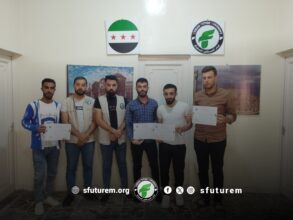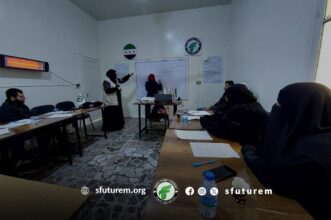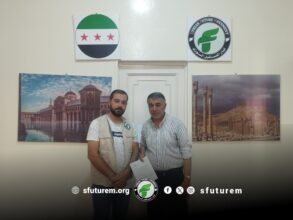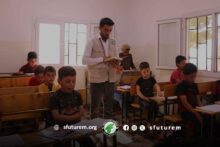Syria Between the Economy of the State and the Militias

Introduction:
The state’s economy is an economic system in which the state has full control over all aspects of production, distribution, and consumption. Its key characteristics include central planning, public ownership, comprehensive government intervention in setting prices and income distribution, with objectives focused on achieving social justice and balanced economic growth.
On the other hand, a militia economy is an informal and illegal economic system controlled by armed factions or militias. Its defining features are the absence of the state and oversight, operating parallel to the official economy of the state, relying on force, and engaging in illegal activities. This highlights the distinction between the state’s economy and the militia economy, as they represent two completely different approaches to economic management.
The Syrian Economy Before the Revolution:
Before 2011, the Syrian economy was generally classified as a socialist-oriented economy, with elements of a planned economy. This meant that the state played a major role in guiding the economy and setting economic policies, although some private sectors existed.
For this reason, it cannot be classified as a militia economy for several reasons, including:
- Absence of controlling militias: Before the revolution, there were no militias controlling large parts of the economy or imposing their own taxes.
- State control: The state was the only authority authorized to impose taxes and collect revenues.
- Existence of economic institutions: There were both public and private economic institutions operating to a relative extent.
Thus, it can sometimes be compared to the economic system of states, as the Syrian economy was based on:
- Central planning: The state played a major role in planning the economy, setting prices, and distributing resources.
- Public ownership: Many companies and factories were owned by the state.
- Significant government intervention: The government heavily intervened in various economic sectors.
Before 2011, the Syrian economy leaned more towards a state-driven economic system, where the state played a pivotal role in planning and directing the economy. However, there were some mixed characteristics, such as the existence of a limited private sector.
The Syrian Economy After the Revolution:
With the outbreak of the popular revolution, the ensuing complex wars, military escalation, fragmentation of the map, and external interventions, the situation changed drastically, and militia economies spread in areas controlled by various factions, leading to a severe economic decline.
After 2011, the Syrian economy shifted significantly away from the previous state-driven system, blending various elements of state economy, militia economy, and the informal market economy for several reasons:
- Geographical fragmentation: As a result of the conflict, Syria was divided into areas controlled by different forces (the Syrian regime, the opposition, the Autonomous Administration, ISIS, and others), each with its own economic system.
- Weakening of the state: The Syrian state lost its ability to fully control the economy, allowing other actors, including militias, to dominate key economic sectors.
- Parallel economy: The parallel economy expanded significantly, with many businesses and institutions operating outside the official economic framework, making it difficult to precisely define Syria’s economic nature.
- Militia control: Various militias imposed their control over certain areas, collecting taxes and imposing fees on economic activities, creating a type of militia economy.
Thus, the current Syrian economy includes:
- Elements of a state economy: The Syrian regime’s government still tries to maintain some state-driven economic elements in areas under its control, such as price regulation and the distribution of certain goods.
- Militia economic elements: Militias control many economic sectors, impose their own taxes, and engage in illegal trade.
- Informal market economy: The informal economy forms a large part of Syria’s economy, with people working in many activities outside the formal system.
In summary, the current Syrian economy can be described as a “hybrid economy” that combines various and conflicting elements. This makes it difficult to assess Syria’s economic performance accurately and has a significant impact on the lives of Syrian citizens. The key factors influencing the Syrian economy include:
- Ongoing conflict: The conflict heavily impacts the Syrian economy, leading to the destruction of infrastructure, displacement of people, and rising unemployment and poverty rates.
- Economic sanctions: Economic sanctions imposed on Syria have contributed to the worsening economic situation.
- Capital flows: Syria relies heavily on international aid, which is affected by political and regional developments.
On the Transition Journey:
The transition from a hybrid or militia economy to a state economy in Syria is a complex and long-term process that requires a comprehensive set of actions, which include:
- Ending the Conflict:
- A. Political solution: Establishing a comprehensive political solution that ensures a peaceful transfer of power and free, fair elections.
- B. Ceasefire: An immediate and permanent ceasefire and the disbanding of militias.
- C. Counterterrorism: Eliminating terrorist groups and shabiha militias that exploit the conflict for their own goals.
- Rebuilding the State and Institutions:
- A. Public sector reform: Rebuilding government institutions and strengthening their capacity to provide public services.
- B. Judicial reform: Establishing an independent and effective judiciary that upholds the rule of law.
- C. Anti-corruption efforts: Implementing effective mechanisms to combat corruption and promote transparency and accountability.
- Reconstruction of Infrastructure:
- A. Restoring essential services: Rehabilitating electricity, water, sanitation, and telecommunications networks.
- B. Rebuilding cities and villages: Reconstructing destroyed homes and public buildings.
- C. Private sector development: Encouraging private investment and creating new job opportunities.
- Economic System Reform:
- A. Currency unification: Unifying the national currency and eliminating currencies circulated in different areas.
- B. Banking system reform: Rebuilding the banking system and strengthening its oversight.
- C. Account auditing: Conducting a comprehensive audit of state accounts and public institutions.
- D. Tax system reform: Establishing a fair and efficient tax system that ensures the collection of necessary state revenues.
- Building Trust:
- A. National dialogue: Holding an inclusive national dialogue that brings together all concerned parties to build trust and unify visions.
- B. National reconciliation: Working towards national reconciliation and rebuilding the social fabric.
- C. Promoting human rights: Respecting human rights and citizens’ freedoms.
Challenges Facing This Transition:
- Ethnic and sectarian diversity: The significant ethnic and sectarian diversity in Syrian society makes achieving national reconciliation difficult.
- Foreign interventions: External interventions in Syrian affairs further complicate the crisis.
- Widespread corruption: Corruption undermines trust in governmental and non-governmental institutions and negatively affects the reform process.
- Lack of resources: The reconstruction process requires substantial financial resources, and securing these resources may prove difficult.
The transition to a state-driven economy in Syria requires strong political will, international support, and the combined efforts of all concerned parties. It is important to note that this transition will take a long time and may face numerous challenges and obstacles. The Syrian economy will also need financial and technical support from the international community, in addition to ensuring that the transition process involves the participation of the Syrian people in decision-making.
Conclusion:
Every economic system has its problems and downsides, and there are certainly alternatives to both the state economy and the militia economy! The ideal economic system is one that combines the advantages of both systems while avoiding their flaws, and this is often referred to as a “mixed economy.”
A mixed economy is an economic system that combines both private and public ownership, as well as central planning and free market planning. The state intervenes in the economy to regulate and guide it, while also allowing for a strong private sector to exist.
The benefits of a mixed economy lie in its ability to capitalize on the strengths of both systems. It combines the flexibility and innovation found in a free market economy with the ability to achieve social justice and sustainable growth characteristic of a planned economy.
Moreover, a mixed economy avoids the drawbacks of both systems. It reduces the negative aspects of a state economy, such as bureaucracy and lack of incentives, while also mitigating the disadvantages of a free economy, such as severe income inequality and economic recessions.
Another advantage is the balance between freedom and responsibility, providing a harmony between individual economic freedom and the state’s responsibility to society.
Examples of mixed economies include most developed countries, such as the United States, Western Europe, and Japan.
Therefore, transitioning to a mixed economy requires several steps that should be considered in the process of building a new Syria:
- Gradual reforms: Economic reforms should be implemented gradually to avoid economic and social shocks.
- Institution building: Strong and transparent economic institutions, such as central banks and stock exchanges, must be established.
- Private sector development: The private sector and foreign direct investment should be encouraged.
- Social safety net: A social safety net must be provided to protect vulnerable groups during the transition.
A mixed economy represents a more flexible and sustainable economic model than a state or militia economy, offering a better balance between economic and social goals.
The Economic Office
Research Team
Research and Studies Department
Articles
Syrian Future Movement






